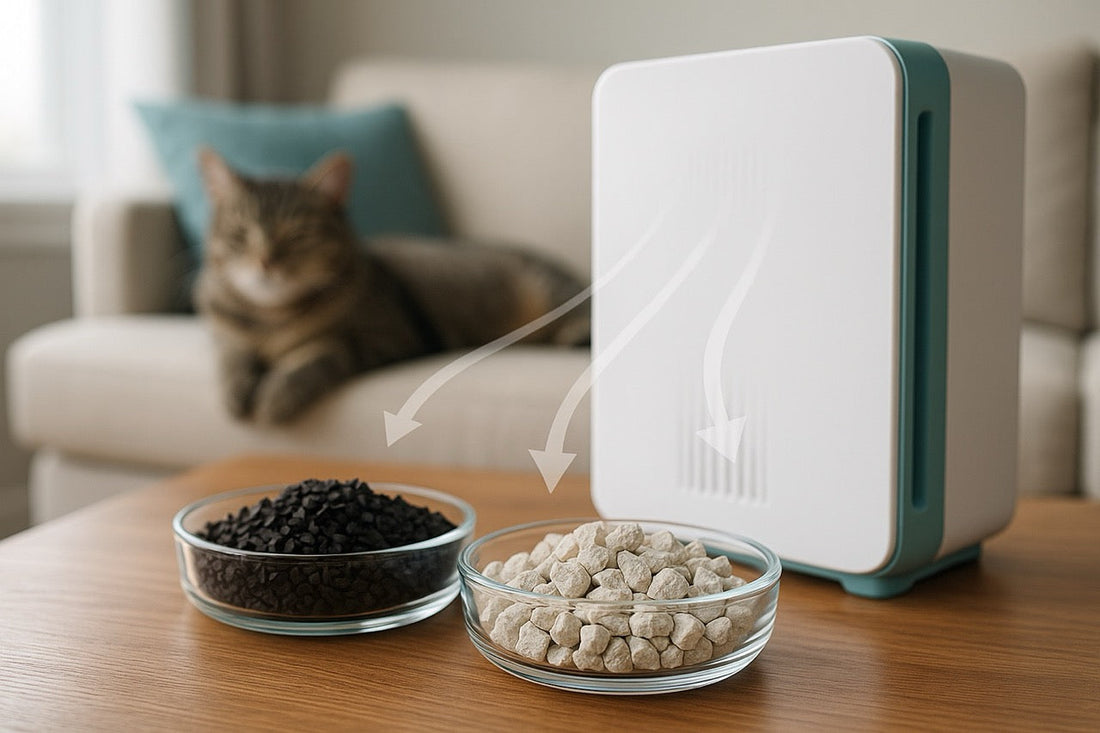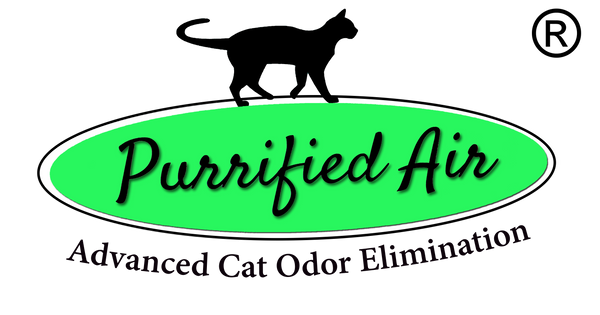
How Activated Carbon and Zeolite Work Together to Make Your Home Free of Cat Odors
Share
Two Unlikely Minerals, One Noble Mission
There are certain facts of cat ownership that everyone quietly accepts. The cost of litter that claims to smell like pine. The discovery of fur in your coffee. The box of gravel in the corner that does not smell like pine at all.
We live in a world full of scent control. Candles, diffusers, smart purifiers. Entire industries revolve around managing how air smells. And yet, in many homes, the strongest scent still rises from a plastic box filled with waste.
Cat odor is not just unpleasant. It is persistent and chemically complicated. It spreads. It settles into fabrics. It waits. It becomes part of the atmosphere, in the way old paint or bad lighting becomes part of a room’s identity.
Most people try to live with it. They crack a window. They buy something labeled "fresh linen." They hope it fades.
But air does not fix itself. And odor does not leave out of politeness. It has to be removed. This is where chemistry matters.
Why Cat Odor Is So Persistent and So Chemical
Cat waste releases a complex mix of airborne compounds. These include ammonia, sulfur-based gases, and a shifting range of organic molecules that travel easily and settle into soft surfaces.
Ammonia forms as urea begins to break down. Its scent is sharp and immediate, often irritating the nose, throat, and eyes. Sulfur compounds introduce notes of decay, while smaller organic molecules spread into fabric, wood, and walls. Together, they create a scent that defines a room.
These particles move quickly and attach to nearby surfaces. Curtains, cushions, floorboards—all of them hold onto what the air delivers. A cracked window provides short-term relief. Scented sprays often create a blend of floral top notes and unresolved base odors.
This kind of air changes how a space feels. It becomes heavier, more stagnant, harder to ignore. Effective odor removal depends on chemistry. It begins with materials that engage the problem directly, at the molecular level, and pull it from the air before it settles.
A Burned Material with an Unshakable Work Ethic
Activated carbon begins as something simple. Wood, coconut shell, peat, or coal is heated until it chars, then treated again at extremely high temperatures in a low-oxygen environment. What remains is a material full of empty space, shaped into a maze of microscopic pores. These pores create an astonishing amount of surface area packed into a small volume. One gram of activated carbon can contain more than 500 square meters of internal surface.
This surface is where the work happens. As air passes through the material, odor molecules attach themselves to the inner walls. The process is called adsorption. Nothing soaks in. Instead, the molecules cling to the surface and stay there. Activated carbon does not hide the scent. It removes it from the air entirely.
Because of its reliability, activated carbon appears in all kinds of essential systems. It helps clean water, purify air, and protect lungs in filtration masks. It works without sound or fuss. In a litter box, its strength lies in its ability to trap a broad spectrum of airborne compounds. These are the same particles that make a freshly cleaned room feel like it still holds a trace of something unpleasant.
This material continues to work as long as air passes through it. It does not rely on scent to suggest freshness. It performs without decoration. Just consistent, quiet effectiveness.
Zeolite and the Discipline of Clean Air
Zeolite is a naturally occurring mineral formed when volcanic ash meets alkaline groundwater. Over time, this meeting of fire and water produces a rigid, crystalline structure filled with tiny, repeating pores. These pores are uniform in shape and size, forming a molecular sieve that can sort and trap specific types of particles with incredible efficiency.
What makes zeolite remarkable is its selectivity. It specializes in attracting and holding certain gases, most notably ammonia, the chemical that gives cat urine its pungent aroma. The structure carries a negative charge, which draws in positively charged particles like ammonium ions and holds them in place. Moisture, toxins, and unwanted odors fit neatly into its geometry and stay there.
Unlike activated carbon, which takes in a wide variety of organic compounds, zeolite focuses on a narrower band of problems. It handles the sharp, eye-watering elements of litter box air, especially those that slip through other filters. Its strength is in discipline. It does not chase every molecule. It waits for the ones it was designed to trap.
In combination with activated carbon, zeolite completes the process. One catches the wide net of scent. The other isolates the sharpest pieces and seals them away.
It does all of this quietly, with no moving parts, and no need to announce itself.
A Double Filter That Understands Its Division of Labor
When air moves through a filter that contains both activated carbon and zeolite, each material knows what to do. Carbon handles volume. It takes in a wide spectrum of volatile organic compounds, including the complex odors that come from biological waste such as the hydrogen sulfide, skatole and methyl mercaptan which together give feces its unpleasant bouquet. Its surface pulls molecules in by the thousands and holds them fast. It works quickly and without discrimination.
Zeolite takes a different approach. Its crystalline structure selects for specific compounds, especially ammonia. Where carbon spreads its attention across many molecules, zeolite chooses a few and captures them completely. Together, they form a system that balances reach with precision.
This pairing works because it mirrors the problem it solves. Cat odor is not one thing. It is a blend of many chemicals, released at different times and in different quantities. A broad solution by itself leaves gaps. A narrow one leaves too much behind. But when the two work together, the result is something close to silence.
Each material enhances the other by doing less, not more. They divide the work cleanly and with focus. The result is air that smells like air again.
The Final Trick Is Making It Feel Effortless
A clean-smelling home should not feel like a daily performance. The litter box should not announce itself before you walk into the room. You should not need to mask, reset, or explain anything. The air should just be clean. And that should feel normal.
When activated carbon and zeolite work together, the result is exactly that. No scent, no signal, no effort required beyond placing the filter where it matters. The box stays. The cat stays. The odor quietly disappears.
This is what happens when chemistry is used with intention. The solution does not shout. It works in the background, collecting the things your cat leaves behind and holding them until they are no longer part of the air you breathe.
Let activated carbon and zeolite do what they were designed to do.
